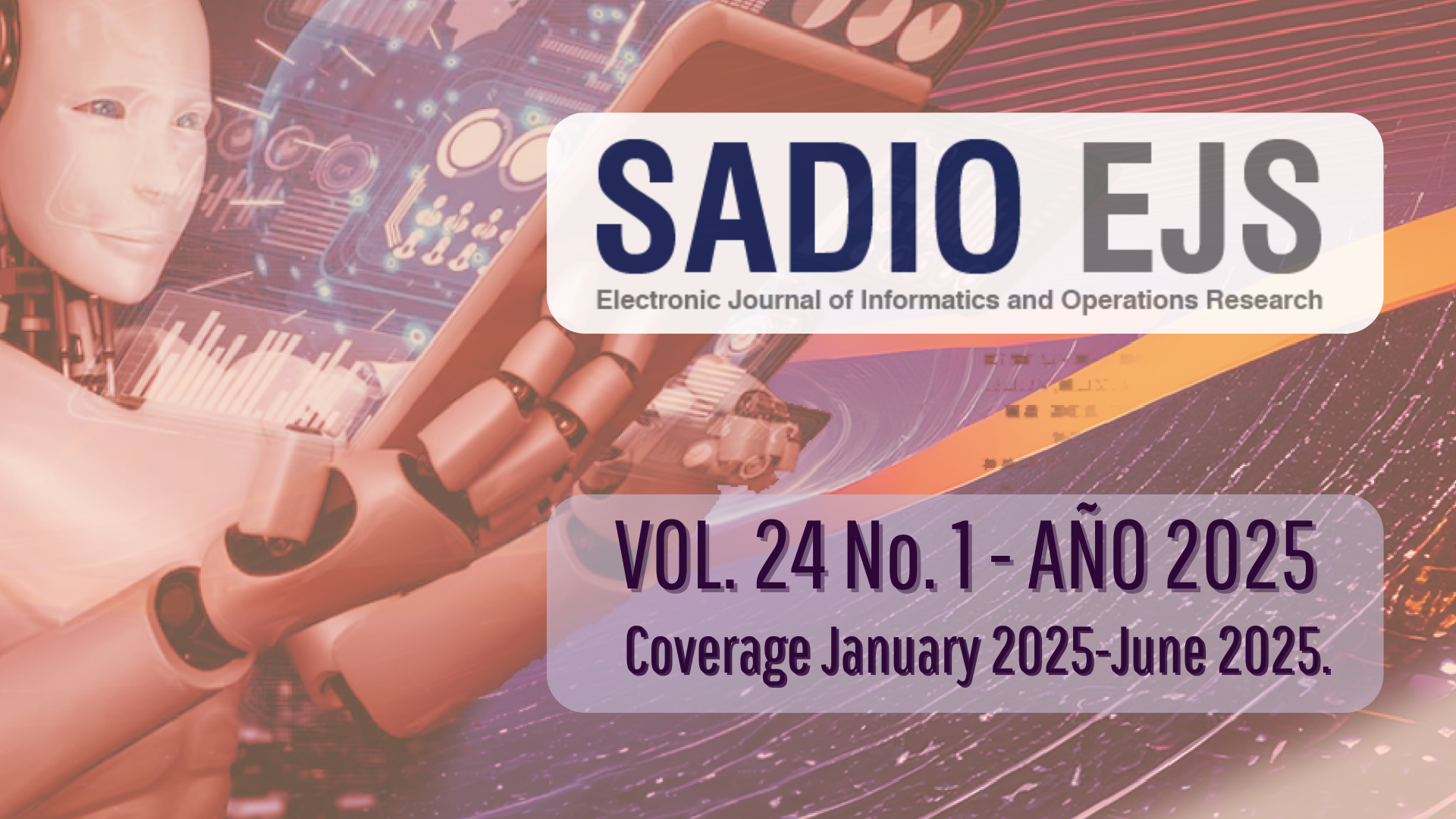Modelado y predicción de la demanda eléctrica: comparación de enfoques estadísticos y de aprendizaje automático
DOI:
https://doi.org/10.24215/15146774e067Palabras clave:
predicción de demanda eléctrica, condiciones climáticas, aprendizaje profundo, red neuronal artificialResumen
Una predicción confiable de la demanda eléctrica es esencial para mejorar la gestión del sistema de distribución, optimizando la utilización de recursos, racionalizando la planificación operativa y reduciendo las interrupciones del servicio. La fluctuación de la demanda eléctrica está influenciada por diversos factores externos, como las condiciones climáticas, sin embargo, las asociaciones intrincadas y no lineales entre la demanda y estas influencias presentan desafíos significativos para la predicción. En este estudio, nos proponemos predecir la demanda eléctrica examinando su relación con las variables meteorológicas en la provincia de Entre Ríos, Argentina. Se emplea una red neuronal recurrente, específicamente utilizando arquitectura de memoria a corto y largo plazo (LSTM), para modelar esta relación compleja directamente a partir de datos de entrada sin ingeniería de características previa. Evaluamos y comparamos el rendimiento de este modelo con un método de referencia. El análisis preliminar de datos revela que las temperaturas extremas ejercen un efecto notable en los comportamientos de consumo de energía. Nuestro modelo propuesto alcanza un coeficiente de determinación de 0.77 al comparar la demanda predicha con las observaciones reales, subrayando su efectividad como una posible solución para optimizar las operaciones del sistema en Entre Ríos.
Descargas
Citas
Pai, Hong, Forecasting regional electricity load based on recurrent support vector machines with genetic algorithms, Electric Power Systems Research, Volume 74, 3, 417-425, ISSN 0378-7796 (2005)
Barak, S. and S.S. Sadegh, Forecasting energy consumption using ensemble ARIMA– ANFIS hybrid algorithm. International Journal of Electrical Power & Energy Systems (2016). 82: p. 92-104.
Zhao, H.-x. and F. Magoulès, A review on the prediction of building energy consumption. Renewable and Sustainable Energy Reviews (2012). 16(6): p. 3586-3592.
Wang Y, Zhang N, Chen X, et al. A Short-Term Residential Load Forecasting Model Based on LSTM Recurrent Neural Network ConsideringWeather Features. Energies. 14(10):2737. (2021)
Wan He. Load Forecasting via Neural Networks. Procedia Computer Science. Volume 122. Pages: 308-314. ISSN 1877-0509. (2017) https://www.sciencedirect.com/science/article/pii/S1877050917326170 https://doi.org/doi:10.1016/j.procs.2017.11.374
Ekonomou, L., Oikonomou, D.S.: Application and comparison of several artificial neural networks for forecasting the Hellenic daily electricity demand load. In: Proceedings of the 7th WSEAS International Conference on Artificial Intelligence, Knowledge Engineering and data bases, pp. 67–71. World Scientific and Engineering Academy and Society (WSEAS) (2008).
Wang, J.M., Liang, X.H.: The forecast of energy demand on artificial neural network. In: Artificial Intelligence and Computational Intelligence. AICI’09. International Conference. vol. 3, pp. 31—35. IEEE Computer Society, Washington, DC, United States (2009)
Kavaklioglu, K.: Modeling and prediction of Turkey’s electricity consumption using Support Vector Regression. Appl. Energy (2011). 88(1), 368–375
Ghalehkhondabi, I., Ardjmand, E., Weckman, G.R. et al. An overview of energy demand forecasting methods published in 2005–2015. Energy Syst (2017). 8, 411–447. https://doi.org/doi:10.1007/s12667-016-0203-y
Rivenson, Y., Zhang, Y., Günaydın, H. et al. Phase recovery and holographic image reconstruction using deep learning in neural networks. Light Sci Appl 7, 17141. (2018) https://doi.org/doi.org/10.1038/lsa.2017.141
Belthangady, C., Royer, L.A. Applications, promises, and pitfalls of deep learning for fluorescence image reconstruction. Nat Methods (2019). 16, 1215–1225. https://doi.org/doi.org/10.1038/s41592-019-0458-z
Pereira, T.D., Aldarondo, D.E., Willmore, L. et al. Fast animal pose estimation using deep neural networks. Nat Methods (2019). 16, 117–125. https://doi.org/doi.org/10.1038/s41592-018-0234-5
M. M. Sachin and Melvin Paily Baby and Abraham Sudharson Ponraj. "Analysis of energy consumption using RNN-LSTM and ARIMA Model", Journal of Physics: Conference Series. (Dec, 2020) vol.1716, n°1, sp. 012048. https://doi.org/dx.doi.org/10.1088/1742-6596/1716/1/012048
P. Vincent, H. Larochelle, Y. Bengio, and P. Manzagol, Extracting and composing robust features with denoising autoencoders, in Proc. 25th Int. Conf. Mach. Learn. (ICML’08) , pp. 1096—1103. Association for Computing Machinery, New York (2008)
R. Sharda, R.B. Patil, Neural networks as forecasting experts: an empirical test, in:Proceedings of the International Joint Conference on Neural Networks, Washington, D.C., Vol. 2 (1990), pp. 491– 494.
Z. Tang, C. Almeida, P.A. Fishwick, Time series forecasting using neural networks vs Box–Jenkins methodology, Simulation 57 (1991) 303–310.
Z. Tang, P.A. Fishwick, Feedforward neural nets as models for time series forecasting, ORSA J. Comput. 5 (1993) 374–385.
Brockwell, P. J., & Davis, R. A. Introduction to time series and forecasting (3a ed.). Springer, New York (2016) https://doi.org/10.1007/978-1-4757-2526-1
Adamowski, J., Fung Chan, H., Prasher, S.O., Ozga-Zielinski, B., Sliusarieva, A.: Comparison of multiple linear and nonlinear regression, autoregressive integrated moving average, artificial neural network, and wavelet artificial neural network methods for urban water demand forecasting in Montreal, Canada. Water Resources Research 48(1) (2012)
Q. Gao, Y. Liu, J. Yang, and Y. Hong, Çomparative Research on Electricity Consumption Forecast Based on Deep Learning" 2nd International Conference on Artificial Intelligence and Education (ICAIE), Dali, China. (2021) pp. 213-217. https://doi.org/doi:10.1109/ICAIE53562.2021.00052
Junior Clony, Gusmão Pedro, Moreira José and Tome Ana Maria M. Time Series Forecasting in Retail Sales Using LSTM and Prophet. Handbook of Research on Applied Data Science and Artificial Intelligence in Business and Industry Copyright. Pages: 22 ISBN13: 9781799869856.ISBN10: 1799869857.EISBN13: 9781799869863. (2021) https://doi.org/doi:10.4018/978-1-7998-6985-6.ch011
Magallanes-quintanar, R., Galván Tejada C., Galván Tejada, J., and Gamboa-Rosales, H., and Méndez-Gallegos, S. and Garcia, Antonio. Neural Hierarchical Interpolation for Standardized Precipitation Index Forecasting. Atmosphere. Vol. 15. Pages 912. (2024) https://doi.org/=doi:10.3390/atmos15080912
R. Jozefowicz, W. Zaremba and I. Sutskever, An empirical exploration of recurrent network architectures, in: Int. Conf. Mach. Learn, pp. 2342-–2350. Association for Computing Machinery, New York (2015) https://doi.org/doi:10.1109/CVPR. 2015.729876
Gutiérrez, E. La demanda residencial de energía eléctrica en la Comunidad Autónoma de Andalucía; un análisis cuantitativo. Tesis de Doctorado. Facultad de Ciencias Enconómicas y Empresariales, Universidad de Sevilla (2003).
Medina, S.; García, J. Predicción de demanda de energía en Colombia mediante un sistema de inferencia difuso neuronal. Revista Energética 33,15-24. (2005).
Murillo, J; Trejos, A. Carvajal, P. Estudio del pronóstico de la demanda de energía eléctrica utilizando modelos de series de tiempo. Scientia et Technica (2003) 23, 37-42.
Kingma, D. P., Ba, J. Adam: A method for stochastic optimization. arXiv preprintarXiv:1412.6980. (2014) Retrieved from https://arxiv.org/abs/1412.6980
Descargas
Publicado
Número
Sección
Licencia
Derechos de autor 2025 Mariela Uhrig, Leandro Vignolo, Omar Müller

Esta obra está bajo una licencia internacional Creative Commons Atribución-NoComercial-CompartirIgual 4.0.
Aquellos autores/as que tengan publicaciones con esta revista, aceptan los términos siguientes:
- Los autores/as conservarán sus derechos de autor y garantizarán a la revista el derecho de primera publicación de su obra, el cuál estará simultáneamente sujeto a la Creative Commons Atribución-NoComercial-CompartirIgual 4.0 Internacional (CC BY-NC-SA 4.0) que permite a terceros compartir la obra siempre que se indique su autor y su primera publicación esta revista, no hagan uso comercial de ella y las obras derivadas de hagan bajo la misma licencia.
- Los autores/as podrán adoptar otros acuerdos de licencia no exclusiva de distribución de la versión de la obra publicada (p. ej.: depositarla en un archivo telemático institucional o publicarla en un volumen monográfico) siempre que se indique la publicación inicial en esta revista.
- Se permite y recomienda a los autores/as difundir su obra a través de Internet (p. ej.: en archivos telemáticos institucionales o en su página web) antes y durante el proceso de envío, lo cual puede producir intercambios interesantes y aumentar las citas de la obra publicada. (Véase El efecto del acceso abierto).





















